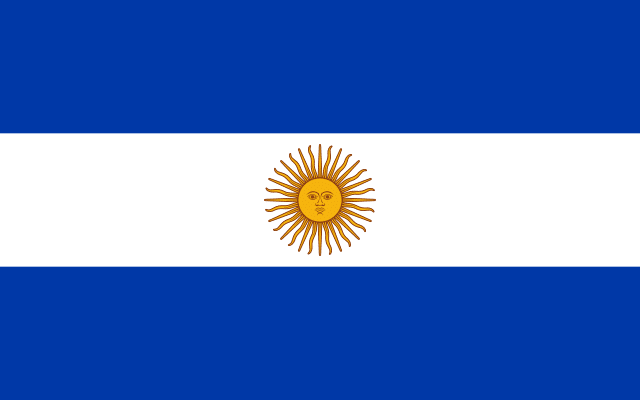Argentina, a country in the center of South America, inspires visitors with its captivating landscapes, passionate tango rhythms, and diverse cultural fabric that reflects the country’s past. The Argentina flag, which represents the country’s people and their core values, is the essence of this magical place.
In this article, we will explore the fascinating history of the Argentina flag. So, let’s learn the meaning of the Sun of May and the mysteries underlying its heavenly blue and white stripes.
Argentina: Country Profile
Geography of Argentina
Before we learn more about the Argentina flag, let’s first do a little overview of the country’s profile. Argentina is located in the southern cone of South America, bordered to the west by Chile, to the north by Bolivia and Paraguay, to the northeast by Brazil, to the east by Uruguay, and the south by the Atlantic Ocean.
With a total area of more than 2.7 million square kilometers, it is the second-largest nation in South America. The Andes Mountains in the west, the lush Pampas plains in the center, and the huge Patagonian plateau in the south are just a few of Argentina’s numerous geographical characteristics.
Due to its extensive geography, Argentina uses several different time zones. Argentina Standard Time (ART), which is UTC-3, is the recognized time in Argentina. Keep in mind that throughout the summer, Argentina follows Argentina Daylight Time (ART), which advances the clock by one hour.

Demographic Overview of the Country
With a population of over 45 million, Argentina is among the most populated nations in South America. The largest city in the nation and its political, cultural, and commercial center is Buenos Aires. The majority of the populace identifies as Roman Catholic, and Spanish is the official language of the country. Argentina is renowned for having a diversified population that has been shaped by waves of immigrants from Europe, especially from Italy and Spain.
Historical Background
Several important events have shaped Argentina’s history. On July 9, 1816, it declared its independence from Spain, beginning its march toward freedom. Waves of immigration occurred in the late 19th and early 20th centuries, adding to the nation’s cosmopolitan character. This time was marked by economic progress and prosperity, with Argentina becoming one of the richest countries in the world.
However, a series of political and economic difficulties followed, including times of political unrest and economic recession. From 1976 to 1983, Argentina was governed by a military dictatorship that was characterized by societal turmoil and violations of human rights. Since then, the nation has tried to achieve stability and economic recovery while undergoing democratic changes.
Argentina Flag Design And Symbolism
The Argentina flag has three horizontal stripes that are each the same width, with the top and bottom stripes being light blue and the center stripe being white. The flag is rectangular in form because its width-to-length ratio is 9:14. The flag’s blue stripes are a nod to the clear sky that spans the vast Argentinean terrain.
The peaceful shade of light blue is a representation of the Argentine people’s history-defining traits of loyalty, honesty, and tenacity. Additionally, it represents the country’s desire for quiet and harmony.
The golden sun, often known as the Sun of May, is the most recognizable element of the Argentina flag and is situated in the middle of the white stripe. The face of the Sun of May is bright, and its 32 rays radiate forth in a ring shape. The sun is a representation of the Inca sun god Inti, who is revered in indigenous cultures as a god of plenty, vigor, and energy.
The blue and white of the flag bring to mind Argentina’s struggle for freedom from Spanish colonial control. They honor the valiant efforts of the liberators who fought for Argentina’s freedom and self-determination.
The birth of a new era for Argentina is symbolized by the Sun of May and its dazzling beams. It stands in for the momentous May Revolution of 1810, which sparked the war for independence. The sun is a representation of hope, optimism, and resiliency for the people of Argentina because of its brilliant face, which heralds the dawn of a better future.
The Argentina flag is also a unifying factor, uniting people from all origins and locations under a single symbol. It helps Argentines develop a sense of pride in their country, a sense of belonging, and common values.
History of Argentina Flag
The intriguing history of the Argentina flag will be explored in this article, along with its most critical turning points and the historical occurrences that influenced it.
Emergence of the Flag
The May Revolution of 1810, a turning point in Argentina’s struggle for independence from Spanish colonial control, is where the Argentina flag’s history begins. The flag, often known as the Flag of the Sun debuted on February 27, 1812. It was designed by General Manuel Belgrano and used the Argentina flag’s official colors of blue and white. In Rosario, where it flew boldly in the face of hardship, the flag was raised for the first time.

Design Evolution
Argentina flag variants first appeared in the early years. The addition of a third red stripe in 1818, signifying the blood poured during the War of Independence, was one major change. However, this style was only temporary, and the flag soon returned to having three stripes.
The Argentina flag included the Sun of May, a symbolic golden sun with 32 rays, in 1818. It stood for the May Revolution of 1810 and how pivotal it was in igniting the nation’s war for freedom, as already mentioned above.

Official Recognition & Standardization
The Congress of Tucumán did not formally acknowledge the Argentina flag as the country’s flag until July 20, 1816. This significant event signaled the flag’s official acceptance as the nation’s uniting emblem.
Argentina Flag Protocol
- The Argentina flag should be respectfully and proudly flown. The flag is traditionally raised at dawn and lowered at dusk. From the viewpoint of the observer, the Argentina flag should be hoisted with the other flags, to the right of the other flags.
- As a sign of grief, the flag is lowered to half-staff. It occurs on national days of mourning as well as to recognize local, national, or international figures. The flag should first be flown at full mast before being lowered to half-mast.
- The blue and white stripes of the Argentina flag should be the only ones that are visible when it is folded into a triangle form.
- The flag should be handled with dignity and respect. It must not be utilized in a disrespectful or commercial manner, nor should it touch the ground.
Argentina Coat of Arms
An important emblem that captures a country’s history, ideals, and identity is its coat of arms. In Argentina’s instance, the coat of arms plays a crucial role in the history of the nation.

Historical Background
The coat of arms of Argentina dates back to the early years of Spanish colonialism. When the Spanish adventurer Pedro de Mendoza founded the city of Buenos Aires in 1535, the earliest documented representation of the coat of arms occurred. Initially awarded to the city, the coat of arms gradually grew to represent a larger area.
The circular form of the Argentina coat of arms, which stands for unification and continuity, is one of its design elements. A two-part oval shield serves as the coat of arms’ primary design element. The Sun of May, a popular emblem also seen on the Argentina flag, is shown in the upper portion as a golden sun with a human face.
The lower portion of the shield has several features that collectively stand for many facets of Argentina’s history and resources. One of them depicts the Ro de la Plata (River Plate), an important geographical feature of Argentina, as a blue and white wavy ribbon.
Interesting Facts About Argentina Flag
- On June 20th of each year, Argentina observes National Flag Day. This day honors General Manuel Belgrano, who designed the Argentina flag, on the occasion of his passing.
- Argentina established a Guinness World Record in 2011 for producing the biggest flag ever. It was unfurled in Rosario and had an amazing 65,145 square meters.
- The colors of the Argentina flag may change at specific occasions or festivals. For instance, the blue and white stripes could be swapped out with rainbow-colored ones during LGBT pride celebrations.
- In 2012, the original banner made in 1812 by General Manuel Belgrano was found after going missing for more than a century. It is presently kept at Buenos Aires’ National Historical Museum.
- It is said that the sun that shone in the sky on May 25, 1810, during Argentina’s freedom from Spanish control served as the model for the Sun of May on the flag.
Bottom Line
The Argentina flag serves as a representation of the country’s long history, thriving culture, and unyielding character. Argentina’s historical hardships and victories, as well as its bright future, are captured in its trademark blue and white stripes and the blazing golden sun.
The people of Argentina are reminded of the valiant people who battled for the sovereignty of their country through the flag, which stands for unity, independence, and freedom. It acts as a permanent reminder of the numerous sacrifices made by people who helped Argentina advance and thrive.